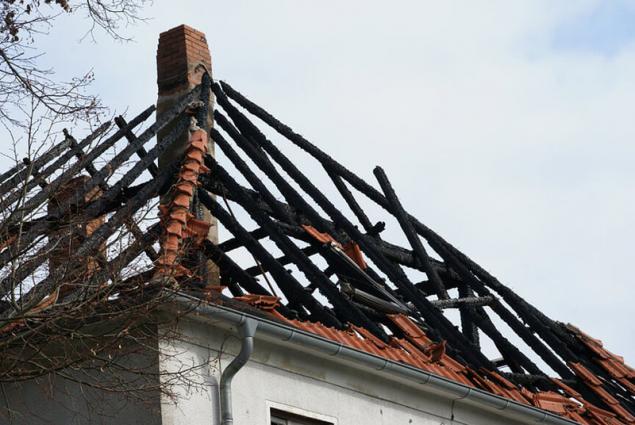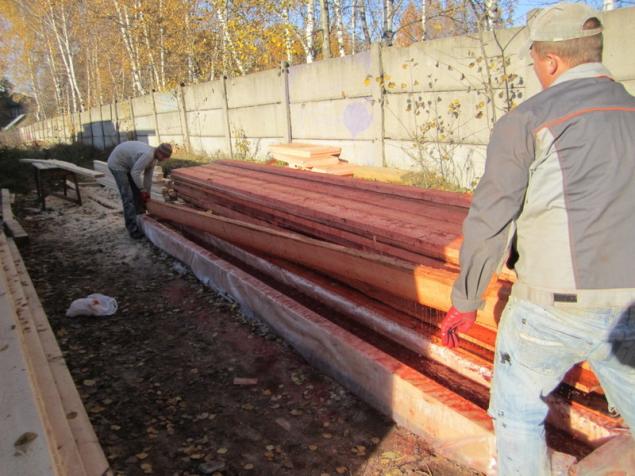What building materials hazardous in a fire
 Bashny.Net
Bashny.Net
How to avoid such troubles? Try concisely to disassemble most "hot" (in every sense) building materials in our cottages.
How to start a fire
Easier to prevent fire than to extinguish it. This truth is as if was created and crystallized for country houses.

Lightly hanging from a curtain near the fireplace, burned in the attic of the knee of the old chimney had fallen out of an overflowing chimney of the furnace on unprotected floors red-hot embers falling on dry rag "cold" sparks from under the spinning stone grinders, forgotten included iron old design (see photo) — here is a short list of "firing" situations involving myself or people close to me. And how much more variety, random fires could think of you, dear readers, and tell us about them in the comments?

Therefore, it is important to know how they may behave during a fire the materials from which our built cottages. If you're just starting construction, and fire safety measures and the proper application of modern materials can still be taken into account in the design of the house. And even if your cottage for decades, it makes sense to hold a series of upgrades to increase fire resistance of the building. For example:

These problems are, as expected, systematically and comprehensively set forth in the fire code: "Materials of construction. Decorative-finishing and facing materials. Materials for flooring. Roofing, waterproofing and insulating materials. The fire hazard indices" (NPB 244-97).

A concise take a look at with glances of fire the science of materials. They are divided into 2 types: combustible and non-combustible. They also klassificeret on characteristics such as:
On the other hand, on the purpose and application of building construction materials and products in the most General approach can be divided into:
The biggest problem with a fire retardant point of view, come up with finishing materials.

Most of them are presented polistirolnymi tiles, PVC and MDF panels, Wallpaper and related to fuel. Widespread linoleum and received a truly national popular shingles are included in the same group.
Of particular danger are varnishes and paints. They not only increase the Flammability of the surface on which it is applied, but also accelerate the spread of fire, increase the smoke density and toxicity. While the main product of combustion (carbon monoxide gas) are added and other toxic substances.
Apart in the list of fire hazards are thermal insulation materials. The fact is that among this group there are completely non-combustible materials (foam glass), and materials, fusion which generates deadly gaseous chemical compounds. Talking about polystyrene — mesh and extruded. Therefore, to use plates of this magnificent for all other parameters of the material should be only in those places where he doesn't get open fire. For example, for insulating a basement, basement or blind area.
Pleasant exception — insulation materials of stone wool . Its fibres start to melt only at a temperature of about 1000 °C. That is, in a real fire this material does not burn. Moreover, there are types of mineral wool, designed purely for the creation of fireproof barriers. Is the wood? Talking about wood, widely used in cottage construction, we left at the end of the article. Of course, that the tree may light you knew before. However, from the banal statement it is reasonable to move on to real action, if not eliminating, then at least hinder this radiant process.
Achievements of construction chemicals significantly reduced the combustibility of wooden buildings. How to choose flame retardants and how to use them?

Should not be tempted by means of the combined fire properties. Choose only sniper fire retardant compositions suitable for preventing ignition of the natural material.
Industry experts know that even a seemingly compatible in the solution of compound will not give positive amplification effect, but also to reduce the bio - and fire-resistant properties of each other. This truth I heard from the head of the scientific-test centre of the company "Rogneda" — one of leading specialized enterprises in Russia.
Deep penetration of the flame retardant into the wood to provide technological soaking it in the tub. Spraying or application of this composition by a brush — levity. Especially if you entrust this operation hired "one-off" Builder. Although the use of tinting compositions increases the diligence of the contractor. The compounds that give the wood a shade of pink allows you to quickly take and monitor the results of fire protection works.

It should be noted that it is not recommended to carry out fire-retardant treatment of wood at negative temperatures. Because the frozen wood has a low absorbency. And this is a serious obstacle to the fact that it gets the required amount of flame retardant. published by P. S. And remember, only by changing their consumption — together we change the world! ©
Source: www.7dach.ru/Oleg_Sanko/kakie-stroitelnye-materialy-opasny-pri-pozhare-72331.html
How to start a fire
Easier to prevent fire than to extinguish it. This truth is as if was created and crystallized for country houses.

Lightly hanging from a curtain near the fireplace, burned in the attic of the knee of the old chimney had fallen out of an overflowing chimney of the furnace on unprotected floors red-hot embers falling on dry rag "cold" sparks from under the spinning stone grinders, forgotten included iron old design (see photo) — here is a short list of "firing" situations involving myself or people close to me. And how much more variety, random fires could think of you, dear readers, and tell us about them in the comments?

Therefore, it is important to know how they may behave during a fire the materials from which our built cottages. If you're just starting construction, and fire safety measures and the proper application of modern materials can still be taken into account in the design of the house. And even if your cottage for decades, it makes sense to hold a series of upgrades to increase fire resistance of the building. For example:
- Completely update the wiring by running it from the copper cable of the brand VVGng-LS, or NYM, "packaged" in a protective shell of fire-retardant PVC plastic;
- To support the update of the transaction electrocommunications modern equipment — UZO, machine guns, etc.

These problems are, as expected, systematically and comprehensively set forth in the fire code: "Materials of construction. Decorative-finishing and facing materials. Materials for flooring. Roofing, waterproofing and insulating materials. The fire hazard indices" (NPB 244-97).

A concise take a look at with glances of fire the science of materials. They are divided into 2 types: combustible and non-combustible. They also klassificeret on characteristics such as:
- Flammability,
- the ability to spread flame over the surface,
- smoke-forming ability,
- toxicity.
On the other hand, on the purpose and application of building construction materials and products in the most General approach can be divided into:
- structural,
- insulation
- finishing.
The biggest problem with a fire retardant point of view, come up with finishing materials.

Most of them are presented polistirolnymi tiles, PVC and MDF panels, Wallpaper and related to fuel. Widespread linoleum and received a truly national popular shingles are included in the same group.
Of particular danger are varnishes and paints. They not only increase the Flammability of the surface on which it is applied, but also accelerate the spread of fire, increase the smoke density and toxicity. While the main product of combustion (carbon monoxide gas) are added and other toxic substances.
Apart in the list of fire hazards are thermal insulation materials. The fact is that among this group there are completely non-combustible materials (foam glass), and materials, fusion which generates deadly gaseous chemical compounds. Talking about polystyrene — mesh and extruded. Therefore, to use plates of this magnificent for all other parameters of the material should be only in those places where he doesn't get open fire. For example, for insulating a basement, basement or blind area.
Pleasant exception — insulation materials of stone wool . Its fibres start to melt only at a temperature of about 1000 °C. That is, in a real fire this material does not burn. Moreover, there are types of mineral wool, designed purely for the creation of fireproof barriers. Is the wood? Talking about wood, widely used in cottage construction, we left at the end of the article. Of course, that the tree may light you knew before. However, from the banal statement it is reasonable to move on to real action, if not eliminating, then at least hinder this radiant process.
Achievements of construction chemicals significantly reduced the combustibility of wooden buildings. How to choose flame retardants and how to use them?

Should not be tempted by means of the combined fire properties. Choose only sniper fire retardant compositions suitable for preventing ignition of the natural material.
Industry experts know that even a seemingly compatible in the solution of compound will not give positive amplification effect, but also to reduce the bio - and fire-resistant properties of each other. This truth I heard from the head of the scientific-test centre of the company "Rogneda" — one of leading specialized enterprises in Russia.
Deep penetration of the flame retardant into the wood to provide technological soaking it in the tub. Spraying or application of this composition by a brush — levity. Especially if you entrust this operation hired "one-off" Builder. Although the use of tinting compositions increases the diligence of the contractor. The compounds that give the wood a shade of pink allows you to quickly take and monitor the results of fire protection works.

It should be noted that it is not recommended to carry out fire-retardant treatment of wood at negative temperatures. Because the frozen wood has a low absorbency. And this is a serious obstacle to the fact that it gets the required amount of flame retardant. published by P. S. And remember, only by changing their consumption — together we change the world! ©
Source: www.7dach.ru/Oleg_Sanko/kakie-stroitelnye-materialy-opasny-pri-pozhare-72331.html
Tags
See also
Samana house of mud and straw with his hands
What kind of light bulbs are the most dangerous — mercury, led or conventional
And what you would save in a fire?
How to insulate wooden walls with their hands
Heating country house WITHOUT gas
Cassowary - included in the Guinness Book of Records as the most deadly bird.
The old system. A collection of the most ancient houses of Moscow
Dangerous method - deceive the enemy.

















